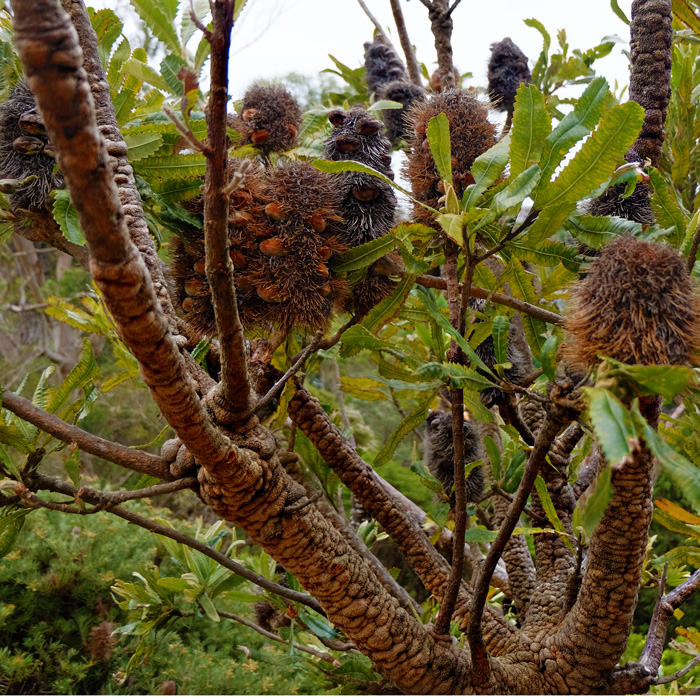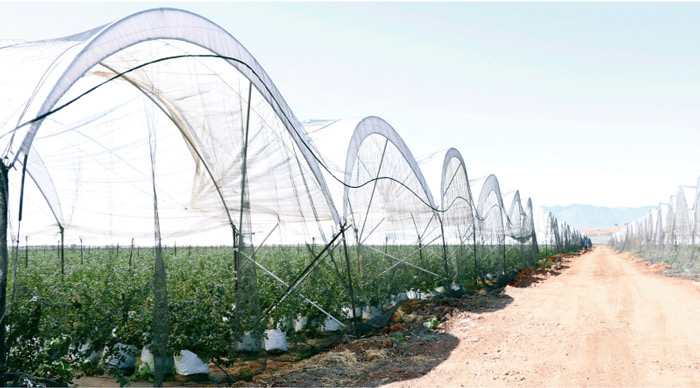Rabbiteyes
Jun 20, 2010
Highbush blueberries in New Jersey are getting riper and riper these days. If you're a commercial-type blueberry and you want to grow bigger and sweeter, the rain and the muggy heat are all good.
Jun 20, 2010
Highbush blueberries in New Jersey are getting riper and riper these days. If you're a commercial-type blueberry and you want to grow bigger and sweeter, the rain and the muggy heat are all good.
Aug 23, 2012

Jan 4, 2014
 Last night, we saw a ram with a pomegranate in Fitler Square, Philadelphia.
Last night, we saw a ram with a pomegranate in Fitler Square, Philadelphia.
Feb 11, 2014
Nov 18, 2014
 The gnarled little trees called wallum banksia thrive in the sandy heathlands along Australia's east coast, from Queensland down into northern New South Wales around Sydney. Tall spikes of yellow-green flowers linger for months on the branches, drying out and turning brown and then gray; the knobby fruits–seed follicles–may hang on the plant indefinitely, at least until a brush fire sweeps across the countryside, which is something that happens there about every seven to twelve years.
The gnarled little trees called wallum banksia thrive in the sandy heathlands along Australia's east coast, from Queensland down into northern New South Wales around Sydney. Tall spikes of yellow-green flowers linger for months on the branches, drying out and turning brown and then gray; the knobby fruits–seed follicles–may hang on the plant indefinitely, at least until a brush fire sweeps across the countryside, which is something that happens there about every seven to twelve years.
Wallum banksia are not harmed by fire, nor by salt spray or nutrient-starved sandy soil or extended drought. The species has evolved to thrive in extremely harsh conditions, in a habitat which, like the species itself, is known as wallum.
Fire may burn up the leaves and branches, but it also pops open the seed follicles, allowing new little wallum banksia to sprout up all around the old ones. Also, the roots often push up new growth after a fire, helping the species reclaim the territory from other opportunistic seeds that might be trying to spread thereabouts.
The specimen pictured here is not in Australia at all, but in the Australian garden area of Wellington Botanic Gardens in New Zealand. The climate in almost all of New Zealand is cooler and far moister than in most parts of Australia, and wallum banksia does not grow naturally in New Zealand. In fact, it is said that the healthiest, largest, fastest-growing specimens are in dry, sunny, fire-prone locations with poor soil comprised mostly of sand.
Dec 21, 2014
Jan 12, 2018
 It's dark, chilly midwinter here in the Pacific Northwest, but the supermarket shelves are piled high with sweet summer raspberries and blueberries and blackberries. All those berries can't be coming from around here–blackberries are notorious weeds hereabouts and other berries grow readily, but the plants are dormant in the winter and yield fruit only in the summer.
It's dark, chilly midwinter here in the Pacific Northwest, but the supermarket shelves are piled high with sweet summer raspberries and blueberries and blackberries. All those berries can't be coming from around here–blackberries are notorious weeds hereabouts and other berries grow readily, but the plants are dormant in the winter and yield fruit only in the summer.
Parts of Chile are climatically similar, though of course with the seasons reversed, and so Chilean berry-growers started loading their fruit on big cargo planes and flying it all the way up here in the wintertime, to be sold at very high prices reflecting the cost of air transport.
Nowadays, however, Chilean berries are all used for juice; the air-shipping premium was just too costly to make them competitive in the fresh-berry market. The huge North American market for fresh berries–which is booming at the moment, thanks to crazes for antioxidants and smoothies–depends on locally grown fruit in the summertime and then, for literally every other month of the year, on berries grown in greenhouse-like plastic tunnels high in the mountains of the Mexican state of Jalisco.
If chilled immediately, fresh berries can have a shelf life of more than a month, which is plenty of time for refrigerated trucks to carry them from their greenhouse tunnels–tuneles–in central Mexico to virtually any grocery store in the U.S.
The high-altitude berry farms, a mile or more above sea level and cooled a bit by Pacific breezes, don't get as searingly hot in the summertime as the rest of Mexico. The semi-shade in the plastic tunnels further blunts the subtropical sun and also slows evaporation, saving water.
But even with all these adaptations, berry bushes and canes in Mexico don't behave the same way they do in, say, Oregon or New Jersey. In Jalisco, the plants rest in the summertime and produce fruit in cooler months–which is just when the North American market has particular call for them.
The tunnels do yield less fruit per acre, but Mexican growers are okay with that; their overall costs are still low. In fact, in the last ten years they have converted so much land to blueberries and raspberries and blackberries that Mexican fresh-berry-production has become a billion-dollar industry.
Mexicans, however, still don't really care for the taste.